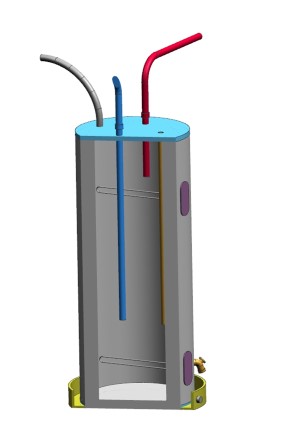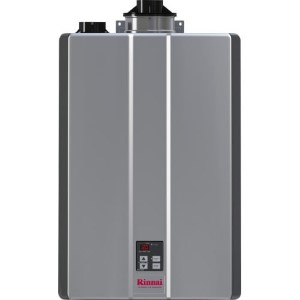- Home
- Water Tank Heater
- Dip Tube Replacement Tips
Water Heater Dip Tube
Installation and Replacement Tips
Instructions on how to replace a water heater dip tube. How it works, and how regular inspection can affect your heater's performance. How to diagnose a dip tube problem? Repair step-by-step guide.
Highlights
- What is a dip tube and how does it work?
- Fighting the sediment buildup problem
- Why the inspection is important, and what can go wrong
- What causes a dip tube to break
- How to diagnose a bad dip tube
- How to repair a broken dip tube
- How to replace a water heater dip tube
- How long does a dip tube last?
- How much does it cost to replace a dip tube?
What is a dip tube and how does it work?
 Electric water heater
Electric water heaterA dip tube is a plastic pipe that delivers cold water from home plumbing to the water heater. It can be found only in tank-type heaters, while it does not exist in tankless.
When looking at the top of the tank-type heater, either gas or electric type, you will notice two plumbing lines; incoming (with the blue ring) and outgoing pipe (with the red ring).
Note: Some water heaters with the cold water port located on the tank's side do not have dip tubes.
The incoming line inside the water heater is a dip tube or cold water inlet extension. This system consists of the plastic tube and metal head, and it goes from the top of the heater, inside the water tank, and ends only several inches from the bottom of the tank.
The cold water enters the water heater and gets heated either by the gas burner or heating elements. As the temperature of cold water increases, it rises to the top of the tank, and from there, it is drawn thru the hot water outlet to the fixture, shower, or any other application. Every time hot water is drawn from the heater, it gets replaced with cold water.
Fighting the sediment buildup problem
As explained before, a dip tube is used to bring the cold incoming water from the home plumbing into the heater - the lower part of the tank. Some manufacturers use this plastic tube as a solution to the sediment build-up problem. A specially designed tube utilizes ports to create turbulent flow inside the heater's tank while preventing the deposits on the tank's heating elements and the bottom.
This advanced design can be found in Rheem and Ruud water heaters as the Everkleen system, Hydrojet in Bradford White, and Dynaclean in AO Smith water heaters. This system is usually called the "self-cleaning system."
Why the inspection is important, and what can go wrong
Inspection of the hot water heater dip tube and potential replacement should be done carefully. The dip tube can wear out, malfunction, disintegrate, or even break. The first symptoms of the broken tube or incorrectly sized inlet tube are "no hot water," slow recovery, and high operating costs. In such cases, cold water enters the tank from the top of the unit but doesn't reach the bottom part; it goes directly into the outlet pipe without being heated (it dilutes hot with cold water).
What causes a dip tube to break
Another problem is associated with the material quality used for building these tubes. As the dip tube is exposed to the water condition and chemistry (water acidity), including different temperatures, it might start falling apart where the small particles can affect the water flow. These pieces can clog strainers, filter screens, and aerators of the fixture or appliance that uses the hot water.
A water heater dip tube that is continuously underwater, due to water chemistry and heat changes its structure, thus becoming brittle and prone to fractures.
As the tube is made of plastic, it softens over time, while a turbulent water flow inside the tank causes the element to break off. The defective dip tube crumbles over time and disintegrates into the tank.
Note: Plastic particles are not toxic, and they do not make water unsafe.
How to diagnose a bad dip tube
The most common signs of a bad dip tube are small broken white plastic particles in your sink aerator or a showerhead, reduced water pressure and flow rate, and hot water that runs out fast.
Inside the tank, disintegrated particles can form something like a paste attached to the wall, while large pieces are sitting on the tank's bottom.
How to repair a broken dip tube
To be honest, you cannot repair a broken dip tube.
The only thing you can do is clean and flush the tank's debris, strainers, and aerators and install a new dip tube. It is recommended to use cross-linked polyethylene (PEX) dip tubes either curved or with openings to create turbulent flow and reduce sediment buildup.
If this approach does not solve the problem, you might have to replace a water heater.
- Find Plumbers In Your Area -
How to replace a water heater dip tube
Required tools
- Plumbing wrench
- Garden hose
- Teflon tape
- Pipe cutter
- WD-40
Instructions
- If you have a gas water heater, turn OFF the gas supply on the gas valve. If you have an electric water heater, turn off the breaker at the electrical panel.
- Turn OFF the water supply to the heater. You can close the valve on the incoming water line or the main shut-off valve, which is usually installed just above the water heater.
- Use the garden hose and attach one end to the drain valve and the other to the open drain. Before draining, open the nearby hot water faucet to vent the heater. Drain several gallons only (or below the inlet connection nipple), but be careful water might be hot.
- To remove the dip tube, you might have to cut the pipe.
- Unscrew the dip tube and inlet nipple by using the pipe wrench and take it out. When dealing with the old heater, you might use some help, such as WD-40 or any other substance for the rust.
- Inspect the dip tube by looking for the cracks, obstructions, and any damage.
- Install the new element, and do not forget to put Teflon tape on the threads to prevent leaking when the heater is full and works under pressure.
Note: Use the flexible hose connector to connect the plumbing and the dip tube (cold water inlet) as it makes the installation and future service easy.
If you require professional assistance contact your local water heater expert!
How long does a dip tube last?
Under normal conditions, dip tubes can last as long as the water heater, even longer. Water heaters with a longer warranty are constructed of commercial-grade features, including the dip tube, making them last for many years. For example, advanced PEX cross-link polymer dip tubes last longer than the standard polymer type.
How much does it cost to replace a dip tube?
Dip tubes for water heaters are not expensive. These elements can cost you between $10 and $30.
According to homeadvisor.com replacing one professionally will cost you around $150. Check out their website to get the most accurate price from your local pro.
Keep in mind that a broken dip tube can reduce your water heater performance leaving you with not enough or no hot water.
Conclusion
As the dip tube is made of plastic and exposed to hot and cold water all the time, it is expected to see it malfunction. When the problem occurs, you have two options; to call a plumber or do it yourself. The guide from above shows how easy it is to remove and replace a dip tube. Either way, you go, the change will ensure great water heater performance and extend the life of a unit.
Related
- Home
- Water Tank Heater
- Dip Tube Replacement Tips




